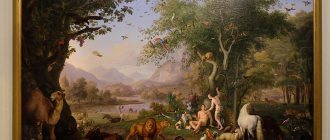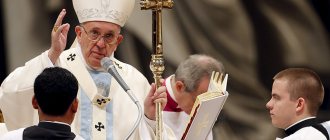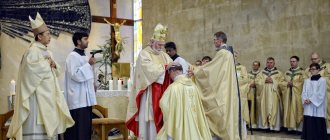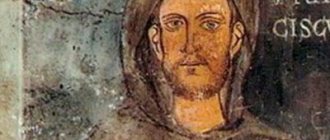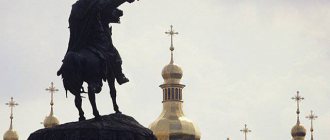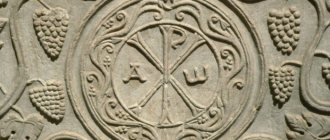Many of us have heard about the Catholic Inquisition - a church court that fought heretics. They were tortured and sometimes even executed. But not many people know that the church also had its own book censorship, which had to check any books before printing.
In this article I will tell you about how in the 16th-20th centuries the Pope and his institutions “selected the right literature” for their parishioners, how they approved a list of “bad” books, and of course we will look at specific examples of such “wrong” authors.
Burning of “heretical” books
The fight of the Catholic Church against heresies and witchcraft. Holy Inquisition. "Witches Hammer"
Heresies are religious teachings that, to one degree or another, deviate from the dogmas of the official church.
The heresies of the early Middle Ages were predominantly of a theological nature (Arianism). Until the 19th century, Western Europe did not yet know mass heretical movements. Isolated cases of speeches by clergy, supported by the local population, against the official church. Based on their social orientation, two main types of heresies can be distinguished: burgher (moderate) and peasant-plebeian (radical). They were aimed at establishing property and social equality. The overwhelming majority of heretical teachings were also characterized by the desire to follow the Gospel, recognizing it as the only source of faith in contrast to the writings of the “church fathers,” decisions of councils, papal bulls, etc. Mystical ideas also enjoyed influence among heretics.
The most massive heretical movement of the 12th century. – Cathar heresy, which was anti-feudal in nature; they refused to recognize the power of the state, rejected physical violence and the shedding of blood. In the 15th century The most significant heretical movements were English Lollardism and Hussism.
The Inquisition played a special role in the fight against heresies. Initially (by the 12th century) - a form of church court, carried out first by bishops, the Inquisition was gradually removed from the control of bishops and turned into the 1st floor. XIII century into an independent organization that had enormous powers and was subordinate directly to the pope.
The Catholic Church responded to the heretical movement with the most ferocious repression. Crusades against heretics were only one of many methods of the pantry's struggle against heresies. The Inquisition gained enormous importance in the fight against heretics. The Inquisition (from the Latin word inguisitio - investigation) was a special church court organized to eradicate heretics. The Inquisition trial was secret, based on the testimony of informers (usually anonymous), was accompanied by severe torture and most often ended in the death (burning) of the accused and the confiscation of their property. The burning of heretics became widespread. Their very execution turned into a kind of religious public “festival” (auto-da-fé in Spain, etc.). The secular feudal authorities usually provided full assistance to the Inquisition, guided, in particular, by the expectation of receiving the lion's share of the property of convicted heretics. To combat heresies, the Catholic Church created a special judicial institution - the Inquisition (from Latin - “search”).
The activities of the Inquisition began in the last quarter of the 12th century. In 1184, Pope Lucius III ordered all bishops that in places infected with heresy, they personally or through persons authorized by them sought out heretics and, after establishing their guilt, handed them over to the secular authorities to carry out the appropriate punishment. These kinds of episcopal courts were called inquisitorial.
At the IV Lateran Council in 1215, compulsory confession was introduced. Persons who evaded it were not allowed to receive communion and were excommunicated from the church with all civil consequences. The Council prohibited the reading of the Bible by the laity and made it obligatory for metropolitans to search for heretics, using lay zealots in inquisition activities. The Council of Toulouse in 1229 demanded the creation of special organizations of the laity that would search for heretics. Since 1227, special tribunals began to be created in those countries and provinces where any heretical movements existed. The Inquisition in Spain was particularly cruel. Thomas Torquemada, the Grand Inquisitor of Spain, introduced the practice of auto-da-fe (act of faith) - public execution of sentences against heretics, and created a code and procedure for the inquisitorial court.
The Dominican Order played the main role in the organization and implementation of the Inquisition. The monks found theoretical justification for their activities in the decrees of the popes and the theoretical arguments of theologians. The names of the German inquisitors Heinrich Institoris and Jacob Sprenger, authors of the book “Hammer of the Witches” (“Hammer on Sorcerers”), became famous. The concept of witchcraft is one of the important elements of medieval religiosity. Until the 13th century. punishments of sorcerers were not widespread. In the 13th century. a view is established on witchcraft as a heresy, which is subject to the Inquisition. Sorcerers are accused of having connections with the devil, from whom they receive their power, in order to inflict all sorts of atrocities on people.
Already under Innocent III, the work of the Inquisition was entirely transferred to the hands of the new monastic Order of the Dominicans or “brothers-preachers,” founded (1207-1208) by the Spanish nobleman Guzman Dominic, specifically to combat heretics. Another monastic Order of the Franciscans, which also appeared under Innocent III, was founded around the same time (1209-1210) by the Italian Francis of Assisi. The goal of this “mendicant order” was to distract the urban poor from heresy. Franciscans had to dress in rough clothing, girdle themselves with rope, and so on. Later, quite soon, the Franciscan Order acquired significant property. The “poverty” of the order advertised by the church was thus temporary and relative and in fact revealed only the crude demagoguery of the papacy in relation to the working masses.
Chi
The essence and formation of heresy
The early Christian Church carefully ensured that the teaching remained in its original purity, resolutely rejecting various distortions of orthodox knowledge. Therefore, the term “Orthodoxy” appeared, which means “correct knowledge or teaching. Since the 2nd century, this concept has absorbed the strength and faith of the entire Church, and the term “heterodoxy” has since that time been used to designate something other than the words of Truth.
Heresy is complete opposition to the true (orthodox) creed.
E. Smirnov notes that in heretical views distorting the divine teaching of Christ there is a systematized sequence, moving from a general concept to a particular one. This happened because Christianity was accepted by pagans and Jews who were not ready to fully renounce idolatry and Judaism. Accordingly, there was a mixture of orthodox knowledge and those ideas that were in the minds of the newcomers.
This is where all the misconceptions regarding church teaching come from.
- The Jewish heretics (Ebionites) sought to merge their own knowledge with Christianity, and soon completely subjugate it. The pagans (Gnostics and Manichaeans) wanted to create a symbiosis of orthodox teaching, Eastern religions and the philosophical system of Greece.
- After the Church was able to reject the first stream of false teachings, other heresies came to replace them, which gained strength on the basis of Christianity itself. The subject of this deliberate distortion was the dogma of the Holy Trinity, and thus anti-Trinitarians appeared.
- Further, heresies delve into more and more specific issues, for example, the Second Person of the One God. This heresy was called Arianism and appeared at the beginning of the 4th century.
On a note! Since the literature of false teaching was destroyed by the ministers of the Church, information can be found in the writings of those who exposed them.
Ardent fighters against the distortion of true doctrine include: Origen, St. Cyprian of Carthage, Clement of Alexandria, St. Augustine, St. Theodoret and many others. The Church also denies other forms of apostasy; it opposes schism and parasynagogue (a private gathering of clergy).
What is a heretic? The fight of the church against heretics
Recognizing state and linguistic boundaries, from the beginning of the 12th century the church began to wield immeasurable power and achieved great power. Not a single event, be it a wedding, the sacrament of birth or death, was complete without the church. The Europeans of that time could not even imagine that things could be different. All everyday affairs, actions, even thoughts were inspired by church dogmas and were part of the order established by the church. The Catholic and Christian world was inextricably linked with religion.
Who was persecuted
At the moment, it is extremely difficult to say how many people were executed for heresy and who they were. You can be sure that these were millions of people, most of whom were innocent. We also note that examples of heretics are most often found within Catholicism.
Mainly worth mentioning is Giordano Bruno. He was a mystic and poet who once became acquainted with the works of Nicolaus Copernicus. Having learned from the notes of a deceased astronomer that the Earth is not the center of the universe at all, but only one of thousands of similar planets, he began to trumpet this to the whole world, which extremely outraged the church. For such “sermons” he was burned at the stake.
Galileo Galilei was next. He, again building on the work of Copernicus, made a new discovery - the Earth rotates. For this he spent more than 8 years in captivity and died in captivity.
Martin Luther is a name that became the basis for the birth of a new religious movement within Christianity - Lutheranism. It is this branch of Protestantism that now dominates in Germany, and also has its “branches” in other countries of the world. Luther was persecuted by Catholics all his life, but they never succeeded in executing him.
Main tenets
Along with the emergence of the main class - the clergy - in the Middle Ages, people also appeared who dared to go against the opinion of the servants of the Lord. This is perhaps the most superficial explanation of what a heretic is. The appearance of heretics occurs at a time when the church approved the main dogmas at its meetings.
- God is one, but can exist in three forms (father, son, Holy Spirit).
- The Church is the unconditional mediator between humanity and the Lord.
- The immaculate birth of Jesus (by the will of the Holy Spirit), etc.
What is a heretic? This is a person who disagreed at least slightly with the main tenets of the church. People who opposed the exorbitant wealth of the highest church ranks were called heretics. In those days, as we know, the richest were not the rulers running the states, but the church elite. Enormous wealth and an incredible amount of land - all this belonged to the church.
Weaknesses Edit
- Animal Blood:
Although it satisfies hunger and keeps the undead alive to some extent, it makes the heretic significantly weaker than he would be if he drank human blood. - Broken neck:
won't kill, but will incapacitate you for a while. - Medicine:
cures vampirism and returns to the state before turning into the dead, i.e. the heretic will again become a siphon. Additionally, the blood becomes a medicine, making it a target for any vampire who wants to cure themselves. - Decapitation:
Dismemberment or removal of the head results in instant and permanent death. - Drying:
Withering Spell: Witches can also use magic to dry out a heretic. This spell can drain any vampire, hybrid, ancient vampire, ancient hybrid, and enhanced ancient vampire.abstaining from blood for a long time ultimately leads to a comatose state.
- Distraction:
Loss of focus and lack of concentration can interfere with the heretic's ability to cast spells. - Emotions:
Anxious emotions and fear caused by danger or pain, real or imagined threat, lead to weakening. - Removing the Heart:
Resulting in immediate and permanent death. - Herbs:
Verbena: external influence leaves burns on the body, and internal influence weakens. It is also impossible to instill in those who have swallowed vervain or applied it to themselves.Taking some herbs can cause you to lose consciousness and prevent you from using magic for an indefinite amount of time.
- Invitation:
It is not possible to enter a residential building without an invitation from the owner. The invitation can be given at a distance and even to those who have not lived in the house for many years. - Magic:
exposure to the powers of witchcraft. This includes mystical objects such as the Gilbert Device, Papa Tunde's Blade, the Cursed Stake, and dark objects. Witches can use magic to cause excruciating pain, causing brain aneurysms or muscle spasms, telekinetically tearing out hearts, breaking necks, etc. - Abuse of Magic:
If the heretic absorbs not enough magic, then strong spellcasting or summoning large amounts of energy can lead to nosebleeds, unconsciousness, and even death. - Overexertion:
Absorbing too much magic from one's blood at once can begin to dry out and eventually die. - Physical Trauma:
Minor injuries such as gunshots, puncture wounds, and broken bones cause pain and also slow you down. However, this is only momentary as the injuries heal completely within a few seconds. - Poison:
Incapacitates when injected. Some poisons can be fatal. - Wood:
Wounded by a wooden weapon, robs strength, causing wounds to take longer to heal. A stab in the heart with a wooden stake results in instant and permanent death. - Tuning fork:
produces a frequency that disrupts mental activity. Causes severe pain to witches, sirens, telepaths, siphons and heretics. - Malivore:
Harms all things supernatural.
The church is corrupt
Many did not like the obligatory payment of church tithes, the sale of church relics and even positions. Of course, fearing reprisals, persecution and punishment from the Lord, people did not seek to express their opinions, although they had personal views on the behavior of the church. But there were knights, wandering monks and simple priests from small villages who, despite their fear, were able to openly express dissatisfaction with the actions of the church. This will, perhaps, be a more accurate definition of what a heretic is.
This is what they called people who believed that the church had become too corrupted by power and exorbitant wealth. The heretics did not see the benefit and need for too expensive church rites and celebrations. The church and heretics were like two sides of the same coin. Some did not understand the reluctance of people to follow the precepts of the church, while others did not recognize the magnificent church services and called on the church to abandon tithes, wealth and lands.
Why is heresy dangerous?
In the Ancient Patericon of 1914 there is the life of Abba Agathon, who was a prudent Christian. When people came to him who wanted to test him and began to accuse him of various passions and sins (pride, fornication, idle talk and others), the wise abba admitted that he was a sinner. But as soon as he was called a heretic, Agathon replied: “I am not a heretic.” The people who came to him asked: “Why did you admit to all the vices except heresy?”, then he replied: “Admitting yourself to be a heretic means excommunication from the Lord, and I don’t want that.”
According to the definition of the holy fathers, heresy is not just a delusion, but persistence in it. Since the fall of the first man (Adam), people's minds have become darkened. Because of this, all people can be mistaken, even Christians, including saints. But if a person, having received edification, realizes his mistake and corrects himself, then he cannot be considered a heretic.
The Gospel as the only source of faith
What did the heretics preach and what did they achieve? People who did not recognize the dogmas of the church believed that the Gospel could be considered the only source of true faith. After all, it is there that it is written that people should be united, should help their neighbors who are worse off than themselves. The heretics called on the church to distribute its wealth and lands to the poor in order to make people equal.
Understanding what the heretics preached, it will not be surprising to learn that they themselves often gave away their wealth, gave the last to their neighbors, and themselves ate what good people gave. Heretics believed that eating alms was not a sin, but, on the contrary, a great power, “the reign of justice and equality.”
Heresies in Islam
In Islam, any religious heresy (“bida”) is strictly condemned. At the same time, any innovation in religion is considered heresy. The terms “mubtadi” (heretic), “zindik” (heretic), and also often “kafir” (infidel) or “munafik” (secret infidel) are used for supporters of heresy.
Traditionally, Sunnis, Ibadis, Shiites, as well as Shiites of different directions, called each other heretics. But now, due to membership in the Organization of Islamic Cooperation, where states with dominance of each of all three movements are represented, the governments of Muslim states usually recognize all three movements as Muslim, although often not equally true. At the same time, following the Salafis, extremist Sunni organizations consider Shiites and Sufis to be at least heretics; The Shiites also have similar organizations. Ahmadiyya is considered a heretical teaching in Pakistan, but is an acceptable Muslim doctrine (along with Sunnism and a number of Shiite denominations) in Iran, where the official denomination of Islam is Twelver Shia. Some new religions that grew out of Islam (such as Salafis, Sikhs, Baha'is, and the Nation of Islam) were initially considered heretical. Currently, the following Islamic movements are most often called heretical:
Forgiveness of sins
In some settlements there were too many heretics. People did not want to remain silent about the unfair (in their opinion) interpretation of the Bible and the forgetting of apostolic poverty. The struggle of the church against heretics in such places became especially tough. Entire armed detachments were sent to the villages, with only one order: “destroy.” The church explained the murders of thousands as true forgiveness of sins.
According to historians, the inhabitants of medieval France were especially opposed to church dogmas. It is known that at the beginning of the thirteenth century entire cities were destroyed. The Catholic Church and the heretics waged a constant struggle. However, the clergy had two advantages - enormous power and untold wealth. Many knights went to kill heretics not because of any of their beliefs and beliefs, but in the hope of getting a decent sum of money.
The most famous banned authors
Throughout history, the Index has included more than a hundred authors. Here I will give a variety of examples:
- Copernicus, Bruno, Galileo and other supporters of the heliocentric (sun in the center) system of the world.
- Casanova, Stendhal, Boccaccio and other writers. For works with an erotic character.
- Dante, Rotterdam, Kant - for their own interpretation of church postulates.
- Rousseau, Montesquieu, Voltaire, Locke, Hobbes, Machiavelli - for criticism of the church and political system.
Jan Matejko "Copernicus. Conversation with God"
Residents of Albi
Perhaps the historical story about the Albigensians will continue to inspire horror and cause open hostility for a long time. In one of the richest regions of southern France, centered in the city of Albi, especially many heretics gathered. It was there that punitive detachments of the Catholic Church were sent. People living in the city believed that the church, like the clergy, was the messenger and servant not of the Lord God, but of the Devil.
After the punitive “operation” of the church and the “forgiveness of sins,” a countless number of French cities were destroyed, including Albi. And not just destroyed, but completely destroyed. Soldiers and hired punitive forces robbed houses, killed heretics and their families, including small children and old people, and burned entire neighborhoods.
According to the chronicle, more than twenty thousand people were killed in one of the cities of southern France. Before the campaign, the soldiers asked the pope: “How to distinguish a “good Catholic” from a heretic?” Today the answer would shock many: “Kill everyone who gets in the way. God himself will then figure out in Heaven who was his own and who was a stranger.”
Why is dogma needed?
—What is heresy—“freedom” of theological and philosophical creativity or just a mistake?
True freedom is freedom from sin and abiding in the Holy Spirit, the Spirit of Truth, which preserves man from error. If heresy is a manifestation of creative freedom, then the theology of the Church Fathers is a manifestation of what? However, freedom can become the basis for a variety of actions, both good and evil.
Heresy is not just a mistake or delusion into which a person falls due to ignorance or an incorrect conclusion. Heresy is a conscious and stubborn distortion of the Holy Tradition, an undermining of the fundamental truths of the Orthodox faith, such a harmful distortion of them that it impedes salvation.
— How can dogmatic formulations be connected with salvation, since in essence they are just forms of thought? How and why does the form of thought affect salvation?
“We must not forget that we are talking about God.” Dogmatic formulations are not just forms of thought, but a kind of verbal image that directs us to the Prototype and warns us against distorting the truth. I recall the Gospel expression “for by your words you will be justified, and by your words you will be condemned” (Matthew 12:37), which is often understood as a warning against vanity and intemperance of the tongue. But if we remember the context of these words of the Savior, we will see that they were spoken as a continuation of the warning against “blasphemy against the Holy Spirit” and, thus, relate not to simple everyday situations when one can really say too much, but specifically to theology! Dogmatic formulations warn and direct us - our mind, our will, our feelings - towards God, serving as a guide for us on this path. So it turns out that - yes, our condemnation or salvation depends on the words about God, with which our hearts agree.
Of course, dogmatic theology is also a form of thought, something that belongs to intellectual culture, but its main goal is to lead a person to salvation. Wrong faith leads to wrong spiritual experience and, as a consequence, delusion and delusion. Dogmatics is not abstract reasoning, not theoretical abstractions, it is the path to salvation. Mental theological error is always reflected in practice, which is why heresy is dangerous! There have been cases in the history of the Church when theological disputes flared up directly around some practical issue: for example, if we remember the history of the Byzantine Palamist disputes of the 14th century, then these seemingly exclusively theoretical discussions around the nature of the “divine light” flared up primarily around Athonite practice “smart prayer” and ultimately allowed theologians to substantiate and defend the Athonite monastic tradition of hesychasm and contemplation of the uncreated divine light.
If a person goes in the wrong direction, after a while he will inevitably end up in a dead end. This is an objective reality, a person, in principle, may not propagate some kind of heresy, but being a heretic, his delusions will still sooner or later bear fruit and reveal themselves with sad consequences.
— Is heresy primarily a “mental” delusion? Is a seminarian with a bad mark in dogmatic theology a heretic?
Army photos on Shutterstock: Army and military photos.
- Well, such a person, as a rule, is no longer a seminarian... (Laughs.) The question here is not whether a person can express his faith, but whether he consciously rejects church teaching, does he contrast his understanding with the church? Most of the heretics were very intelligent people and strict ascetics, but they denied church teaching. Moreover, they denied it at a very high intellectual level: Apolinarius, Nestorius... That is why we explain to our students that it is not so much theoretical knowledge in the field of theology, but the experience of church life, the experience of life in the Holy Spirit that protects against mistakes.
Holy Inquisition
In order to fight heretics even more thoroughly and reliably, the church created special detachments at the end of the 15th century. The Holy Inquisition used all available means to overcome dissent (denunciations, torture, executions). It was at this time that death sentences were imposed by hanging. It was then that those who “conspired with evil spirits,” who used magic, or were witches or sorcerers, became heretics. The church could accuse entire villages of making a deal with the Devil. The 16th and 17th centuries were remembered by everyone for the numerous trials of witches, who were tortured, hanged, burned at the stake, drowned, etc.
Heresies in the Middle Ages
Heretics in the Middle Ages were most often wandering monks and preachers who did not belong to any particular class. This layer was called vagantes, and it included fugitive monks and clerics, actors, etc. Often, the heretical sermon of that time is not a theological dispute as to who is more right, but an anti-church speech, denying the supremacy of church authority, ridiculing the official clergy, rituals and sacraments.
Often heretical ideas were based on Eastern myths and teachings that were brought to the West by merchants and wandering vagrants. As a result, some rather bizarre beliefs emerged.
Medieval heretics had few characteristics in common. The Albigensian heresy is based on Gnosticism; the Waldenses were based on their own vision of the ideals of the times of the apostles. There were also many ancient heresies, for example, anti-Trinitarians.
The popularity of medieval heresies is explained quite simply. Most people did not know how to read, and perceived what the learned man said as the truth. For secular authorities, this was just a way to get new lands and money.
The fight of the church against heretics
Several stages can be distinguished in the church’s struggle against heretics: the struggle directly against heresies and the struggle against individual heretics. The fight against heresies sometimes reached the point of conflict on a European scale - this is what happened with the Albigensians. The fight against individual heretics began a little later, with the advent of the Inquisition.
The Inquisition appeared in 1215, at the height of the war with the Albigensians. The main functions of the new institution were to detect heresies, punish heretics and prevent their spread.
One of the most famous means of struggle was the public burning of a heretic. From the point of view of official doctrine, this was justified. According to the inquisitors themselves, they fought against heresies in any of their manifestations, and the complete destruction of heresies is impossible without the destruction of their supporters.
Despite the fact that the execution of heretics was the prerogative of the secular authorities, failure to comply with the demands of the church court was fraught with accusations of heresy and the secular authorities themselves. Therefore, in most cases the sentences were carried out.
Many people wonder what methods the Inquisition used to identify heretics, because it is quite difficult to determine a person’s religious views offhand. At that time, various methods were actively used, some of which have survived until recently:
- Torture.
- Interrogations.
- Denunciations, etc.
The inquisitors had a fairly developed system of torture. Depending on the specific case, they could either break the will of a potential heretic so that he would admit that he belonged to a heresy, which he first heard about only from inquisitors, or send especially strong ones on the rack or some other similar device.
Video about how the church fought heretics
https://youtube.com/watch?v=T3-MW8-6-ec
The interrogations of heretics took place relatively peacefully. During the process, the inquisitor determined the need to apply torture measures to the interrogated person. Examples of questions that the inquisitors asked are given in a number of books describing the history of the Inquisition. They boiled down to determining how well a possible heretic is knowledgeable in official religious dogmas, and whether he follows them.
Both major religious figures and scientists whose research contradicted official church canons became victims of the active struggle against heresies. Thus, Galileo escaped the fire only as a result of renunciation, and lived the last years of his life under the direct control of the Inquisition. The church admitted its mistake regarding Galileo 350 years after his death.
It must be admitted that the impatience was mutual. New heresies and sects appeared periodically. Thus, a small society of Adamites appeared in the Taborite sect. Its founder, Beggard, called himself Adam, son of God, resurrector of the dead and forerunner of the Apocalypse. The adherents of this heresy believed that they lived to destroy filth. Referring to one line from the Bible, the Adamites could burn villages and villages at night. As a result, this sect was destroyed on the direct orders of Jan Zizka.
We can say that the entire history of religion over the last two thousand years is a struggle between official doctrine and numerous heretics. In some cases it all came down to armed conflict, in others everything ended amicably.
It is impossible to say unequivocally what the heretics preached. In each case there was its own teaching, which had a distant connection with the others. There was no unity among the heresiarchs.
How do you feel about church methods of combating heretics? Tell us about it on .
Joan of Arc
Perhaps the most famous heretic was the Frenchwoman Joan of Arc. The church called her a witch, an assistant of evil spirits, a sorceress. People considered her a national heroine, a savior and a saint.
In the mid-15th century, Joan of Arc was subjected to torture, abuse and a painful death at the stake. She was accused of heresy and sorcery. The most terrible, absurd, terrible, incomprehensible thing is that just two decades later, the case of the witch d'Arc was revised, and the girl was declared innocent by Pope Calixtus III himself. In the mid-twentieth century, she was canonized and called the savior of France. And after Jeanne there was Kaepernick, Jan Hus, Giordano Filippo Bruno, Martin Luther.
These are the most striking documented examples of the church’s struggle against heretics that have survived to this day. The brightest, but far from the only ones. And it is hardly possible to come up with something more terrible than “saving human souls” through the use of inquisitorial tribunals.
Christianity
The Church Fathers identified Jews and Judaism with heresy. They saw deviations from orthodox Christianity as heresy. The theologian Tertullian implied that it was the Jews who most inspired heresy in Christianity. He said, “From a Jew the heretic took the lead in this discussion that Jesus was not the Christ.” Peter of Antioch referred to Christians who refused to worship religious images as heretics.
First known use of the terms
occurred in 380 AD. e. The decree of Theodosius I was issued, as a result of which the church merged with the power of the Roman Empire. Before this decree was issued, the Church did not have state support or any mechanism to combat what it interpreted as “heresy.”
This decree established the division of state powers to ensure law and order with church authorities. The strengthening of the Church gave it the ability to effectively impose a death sentence on those whom the Church considered heretics.
The first official heretic was the heresiarch Priscillian. He was condemned in 386 by the Romans
for witchcraft and executed along with four followers.
After the Reformation, Protestants also persecuted and executed those they considered to be heretics, including Catholics. The last person to be executed by the Catholic Church was the Spaniard Cayetano Ripoll. He was executed in 1826. The exact number of people executed as heretics is still not known.
Catholicism
In the Catholic Church, stubborn and willful heresy is considered spiritually cut off from the Church, even to the point of excommunication. Justinian's Code (1:5:12) defines "all who are not dedicated to the Catholic Church and the Orthodox holy faith" as a heretic. Pope Saint Gregory stigmatized Judaism and the Jewish people in many of his writings. He called the Jews the enemies of Christ: “The more the Holy Spirit fills the world, the more perverted hatred dominates the souls of the Jews.” He called all heresy "Jewish"
, arguing that Judaism will pollute Catholics.
The Church mistreated Christian teachings
, which were considered heretical, but before the XI, the struggle of the church focused on individuals or small illegal sects, such as:
- Arianism;
- Pelagianism;
- Donatism;
- Marsionism;
- Montanism.
The spread of the Paulician sect in the west gave rise to the famous heretical teachings of Western Europe in the 11th–12th centuries. By the 11th century, large organized communities began to appear in southern Europe, such as:
- patarini;
- Dulcinians;
- Waldenses;
- Cathars.
Heresy for the church was the circumstance
which made it possible to unleash European religious wars.
Orthodoxy
In Orthodoxy, heresy refers to those beliefs that were declared as such by the first seven Ecumenical Councils. Since the Great Schism occurred
, Orthodoxy also used this concept in trials against people and movements that were considered heretical.
The Orthodox Church also rejects early Christian heresies such as:
- Arianism;
- Gnosticism;
- Montanism;
- Judaism;
- Nestorianism;
- Monophysitism;
- iconoclasm.
But it should be noted that Orthodoxy has always been more tolerant of heretics than other religions. The witch hunt in Europe almost did not touch the Orthodox lands. There were isolated cases of burning at the stake
, but in fairness it should be noted that, unlike Europe where innocent women were often burned, professional sorcerers were executed here.
The Catholic Church believes that the Orthodox Church is a schismatic (since it rejects the authority of the Pope), but not a heretical teaching. This is due to the fact that its teaching is almost similar to the teaching of the Catholic Church.
Islam
Since ancient times, Muslims have persecuted those who opposed Islam: accusations were punishable by death. Even today in some Muslim countries heresy is punishable by death.
Judaism
Judaism considers Jews who deviate from traditional Jewish principles to be heretics.
Former German Catholic monk Martin Luther was labeled a heretic by Pope Leo X in 1520. Until now, the Papal decree has not been repealed, and Lutheranism is today considered the dominant religion in Germany.
An example of a person
Having a different opinion from the church, one can name the famous scientist Galileo Galilei, who was answerable before the Inquisition for heresy, but renounced his teachings and spent the rest of his life under house arrest.
